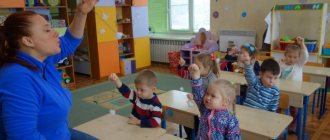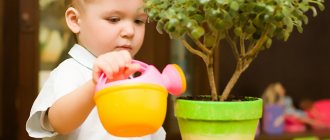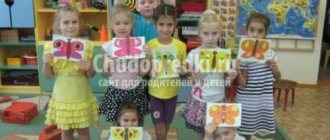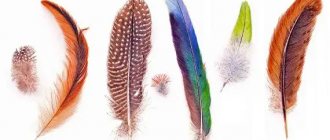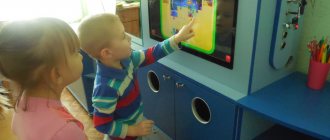Thematic planning on the topic: “poultry”
Target:
Teach to compare two trees based on external characteristics. Teach children to attribute a particular tree to a particular type of forest. Develop observation, attention, thinking, ability to analyze, generalize, and draw conclusions.
D/n
Mode
Joint activities between adults and children
Educational activities in special moments
Organization of a developmental environment for children’s independent activities
Interaction with family, society
(subgroup/group)
Individual
September 25, Monday
Morning
Receiving children outdoors. Looking at illustrations of autumn landscapes. “When does this happen?”
Ts: Clarify ideas about changes in nature that occur in the fall.
Morning exercises No. 4
Reading the poem “Fall of Leaves” by N. Minsky, “Autumn Gamma” by N. Stachnev C: Introducing children to the folk signs of September.
Communication: “Tell me what you saw...”
C: Arouse the desire to conduct a dialogue with an adult, reflecting personal experience in the conversation
Strengthen the ability to use different types of fasteners. Teach to recognize your clothes and not confuse them with the clothes of other children
Work based on illustrations – posters “Take care of the forest from fire”
Solving problem situations: “What would you do?”
C: to form the foundations of environmental education.
Individual interviews at the request of parents
GCD
1.Musical activity.
P/s: Continue to introduce children to musical works from the “Children's Album” by P. I. Tchaikovsky. Develop in children emotional responsiveness to music, the image and content of which are associated with the world of a fairy tale. Continue to teach children to perform songs solo, in subgroups, in choir.
2.PSC. “Trees are not only the decoration of the Earth”
P\s:
Teach to compare two trees based on external characteristics. Teach children to attribute a particular tree to a particular type of forest. Develop observation, attention, thinking, ability to analyze, generalize, and draw conclusions. Develop coherent speech in children. Cultivate love and respect for native nature. (Collection of notes on PSTS, pp. 
Walk
Crow observation.
C: Reinforce that the crow is a wintering bird, teach to notice and name the characteristic features of appearance and behavior.
P/i "Carousel" (running in a circle); p/i "Fishing Rod" (develop reaction, ability to jump)
Experience: Earth's gravity." Leaves fly to the ground"
Ts: Prove experimentally that the Earth is a magnet, attracts even light objects to itself.”/learning to notice and name the characteristic features of appearance and behavior.
plants.
Continue to teach different ways to construct coherent text using a diagram.
Didactic games: “Sound Lost” - to consolidate the ability to identify sounds in a word and develop phonemic hearing.
Calendar planning in the senior group on the topic “Poultry”
Olga Georgieva
Calendar planning in the senior group on the topic “Poultry”
Goal: To improve children’s understanding of poultry (diversity of species, subspecies, appearance, habits, food)
.
Form environmental ideas. Develop the ability to establish simple connections between living and inanimate nature, adaptation to the environment. Expand your understanding of the rules for caring for poultry , keeping them, and their significance for humans. Foster a caring and caring attitude towards poultry .
Final event: collective work from various materials “Bird Yard”
.
Morning exercises: Complex No.
Invigorating gymnastics: Complex No.
Education of KGN: continue to teach to notice disorder in clothes and eliminate it.
Work with parents: Consultation – workshop “The role of didactic games in the family and etc.”
GCD Joint activity during special moments Individual work Creation of a subject-specific spatial development environment
Monday 02.12 I half of the day 9.00-9.20 Familiarization with the subject area. and the social world
9.00-9.50 Speech therapist
10-10.25 Music Conversation with children “ Poultry ”
Goal: To improve children's understanding of
poultry (diversity of species, subspecies, appearance, habits, food)
.
Classification of animals (wild and domestic )
similarities and differences.
Looking at plot pictures about birds .
D.I.: “Who lives where?”
,
“Who eats what?”
D.I.:
“Who lives where?”
,
“Who eats what?”
A selection of illustrations depicting
poultry .
Introduce figurines of poultry
Board games: “Who lives where?”
,
“Who eats what?”
.
D/i “Who is whose cub”
(on flannelgraph)
Walk: Look at the card index
II half of the day Evening. Regional component. " Poultry of our region "
D/i “Choose houses for birds .
Reading works about birds .
Role-playing game "Farm"
: game situation
“Feeding
the birds ” .
Walk: See card index
Working with parents: Recommendations for parents on working with children at home “How to foster independence”
.
Reading fiction: B. Zhitkov “The Brave Duckling”
, Russian folk tale
“The Cockerel”
GCD Joint activities during special moments Individual work Creation of a subject-specific spatial development environment
Tuesday 03.12 I half day 9.00-9.20 FEMP
9.30-9.50/10.00-10.20 Speech therapist
10.30-10.55 Physical education Guessing riddles on the topic . Talking about birds based on mnemonic tables.
Conversation with children: “Rules for handling
poultry ” (do not come close, do not shout, do not tease)
.
D/i: “Who eats what?”
Verse “Important Goose”
“Who says what?” (loud-quiet)
Attributes for role-playing games: “At Grandma’s in the village”
,
“Let's treat
the birds ” ,
“Hospital for
birds ” Cut-out pictures, inserts on the topic .
Construction of familiar buildings from large and medium-sized construction kits.
Riddles on the topic
Walk: See card index
II half day 15.40-16.00 Modeling
Games with building materials: “Let’s build a house for a chicken”
D/i “Like a crested hen”
,
“Who is screaming?”
,
“What did the artist mix up?”
,
“Who needs what?”
..
Walk: See card index
Working with parents: Writing a story about a pet .
Reading fiction: G. -H. Andersen "The Ugly Duckling"
, fairy tale
“Chick Chick and Fyodor the Cat”
.
Wednesday 04.12 I half of the day 9.00-9.20 Speech development.
9.00-9.50 Speech therapist 10.00-10.2 5Music
Conversation: “How people take care of poultry ”
.
D/i “It is possible and it is not possible”
,
"Find out by description"
,
D/i “Find a Pair”
(chicken - rooster)
S/r game “Farm”
, game situation
“Feeding
the birds ” Verse
“I herd geese”
D/i
“Call me affectionately”
,
“Find a mate”
Replenishment of the book corner on the topic
Offer children coloring pages for free coloring,
stencils, outlines on the theme “ Poultry ”
Walk: See card index
II half day
Coloring pictures of pets and birds . Drawing using stencils and strokes. D.I.: Domino, “Find out by description”
Walk: See card index
Working with parents: Conversation at home “How people take care of pets and birds .”
Reading fiction: N. Emelyanova “Oksya the hard worker”
, Ukrainian folk tale
“Spikelet”
Thursday 05.12 I half of the day 9.00-9.20 Cognitive development To consolidate children’s ideas about poultry , structure, differences and similarities with other representatives of the animal world.
9.35-10.00 Drawing Conversation about the meaning and benefits they bring. Reveal knowledge about lifestyle, habits, and food preferences. Correlate the lifestyle with environmental conditions, their adaptation to conditions and habitat, etc.
D.I.: “What do birds give to humans ?”
D/i “Count the birds , who is more, who is less?”
P/N: “Fox, chickens”
D/i:
“Count
the birds , who is more, who is less?” Add puzzles, “Put it together”
;
cubes " Poultry "
;
Contribute the painting “Hen with Chicks”
"Mnemonic table"
Walk: See card index
II half day
Joint activities of a speech therapist with children. Verse "The Goose Got Angry"
D/i “4th extra?”
,
“Put the puzzle together”
,
“Color the picture”
Compiling a story using a mnemonic table.
Walk: See card index
birds in children ”
Reading fiction: O. Donchenko “Petrus and the Golden Egg”
, M. Prishvin
“Guys and Ducklings”
.
Friday 06.12 I half of the day 9.00-9.20 Speech development
9.55-10.20 Physical education
Speech therapist
Classification of birds (wild and domestic )
similarities and differences.
“Why are the tracks different?”
(matching
bird paws with footprints ) - D\game “Describe the picture”
- compiling a short descriptive story of 3-4 sentences.
D/i “4th extra?”
Bring in colored pencils, markers, stencils, coloring books, templates, stencils on
the topic
bird tracks
Classification of birds by pictures
Walk: See card index
II half day 15.40-16.00 Application/design
Scientific research “Animals, birds ”
Who has what clothes? (feathers, wool, leather)
.
— r\i: “What can animals and birds ?”
- created various phrases
Walk: See card index
Working with parents: Recommendation of didactic games on the topic (Play at home with children )
Reading fiction: E. Blyton “The Famous Tim Duckling”
(chapters)
in trans. from English E. Papernoy
Thematic plan for the week “Poultry”
Zainab Idiatulina
Thematic plan for the week “Poultry”
Calendar and thematic planning
Topic : " Poultry "
Goal: To systematize ideas about poultry , their habitats, nutrition, voice, members of bird families, benefits for humans.
Implementation period from 02/02/2015 to 02/06/2015.
Form and name of the final event: Exhibition of children's works
Day of the week Regular moments Joint activity of adults and children, taking into account the integration of educational areas Independent activity of children
Integration of the region Group, subgroup work Individual work Educational activities at special times
Monday
02.02.15 Morning
Conversation: “What did you see on the way to kindergarten”
changes in the weather - develop children's powers of observation.
Articulation gymnastics card library
Morning exercises
P/i " Poultry "
page 57 Lex. Topics
Labor: watering flowers - helping to increase the independence of children with Dasha, Olesya, Maxim
Printed board games : Poultry lotto
GCD 1. Formation of a holistic picture of the world
«Poultry and their young»
Goal: To systematize ideas about poultry , their habitats, nutrition, voice, members of bird families, benefits for humans.
GCD 2. Artistic and aesthetic development.
Music.
Walk
Observation: “The beauty of the winter landscape”
- develop aesthetic perception.
P/i "Geese - geese"
— to develop in children endurance, agility, and control in fast running.
Game exercise “Crawl into the tunnel”
— development of motor activity
Labor:: Removing snow on the site - cultivate responsibility, hard work, encourage the desire to be useful.
Developmental exercise: Walking like a snake along a snow bank with Nikita,
Rita, Danil
Snowball game. Ice skating downhill.
Afternoon:
Compiling a story based on plot pictures “At the veterinarian’s appointment”
of poultry in speech .
Finger gymnastics “Ducklings”
D/i “Who Screams How”
Develop attention, quick-witted memory.
Julia, Dasha, Igor.
Awakening gymnastics Breathing gymnastics
S/r game "Doctor Aibolit"
develop independence and play skills.
Walk
Observation: ice. Examine the formed ice areas on the territory of the kindergarten.
P/i "The Hunter and the Hares"
develop reaction speed, dexterity, motor activity.
Developmental exercise “Hit the target”
-Develop children's throwing strength and accuracy.
Labor: Sweep the floor on the veranda - develop labor skills and independence.
I/R: Walking with long strides with Dima, Dasha, Yulia.
Sledging. Snowball games.
Tuesday.
02/03/15 Morning
Conversation about the work of a veterinarian - continue to introduce children to the profession, teach them to participate in the conversation.
Reading the tongue twister: “The goose bought himself an accordion”
Morning exercises
Sedentary game “Guess who I am”
imitate the movements
of poultry , enrich the motor experience of children.
Reading of A. Krylov’s poem “How a rooster was treated”
— discuss the content of the poem with Lisa, Egor, Arina, Dima.
Game situation “Wonderful combs”
To develop in children the desire to take care of their appearance.
S/r game “In the Poultry Yard”
- promote children’s mastery of various ways of joint activities.
GCD 1. PR FEMP
Purpose: To introduce the quantitative composition of numbers 3 and 4 from units. Introduce the number 9. Continue to teach how to navigate on a sheet of paper, identify and name the sides and angles of the sheet. Strengthen the ability to consistently name the days of the week .
Fizminutka
GCD 2.HER Drawing: “Rooster painting”
Goal: To teach children to paint a sculpted toy based on Dymkovo or other folk ornaments. Develop aesthetic senses (rhythm, color, composition, aesthetic perception. Develop creativity.
GCD 3. Physical education according to the physical instructor’s plan
Walk
Observation: ice - teach children to see cause and effect relationships between weather phenomena.
P/i "Geese - geese"
Develop reaction speed and agility.
Labor: sprinkle sand on the paths to teach children to complete the task independently.
Developmental exercise “Ice tracks”
Maintain balance when moving along ice paths
(Gleb, Polina, Nikita)
Ice skating downhill
Afternoon
Finger gymnastics “Ducklings”
Theatrical performance “The Ryaba Hen”
Roles are played by children to help improve expressive speech.
Learning the nursery rhyme "Chick - chick - chicks"
Develop memory, activate speech
(Julia, Dasha, Kolya.)
Awakening gymnastics. Breathing exercises.
Plot-based role-playing games help increase children's independence when choosing games.
Walk
Observation “Where and how icicles are formed”
— teach children to draw conclusions and develop logical thinking.
P/i “Reindeer Sleds”
running with high knees.
Labor: we sprinkle sand on the paths in the area of the younger group. Educational game “Walk the snow snake”
exercise on
development of coordination of movements (Maxim, Kostya, Polina)
02/04/15 Wednesday
Morning
Didactic game “Say the opposite”
consolidate the use of words - antonyms in children's speech.
Articulation gymnastics
Morning exercises
P/i "Bug - Spider"
coordinate the movements with the text.
Solving the Riddles: " Poultry "
— to develop observation, attention, thinking
(Gleb, Roma, Yulia)
Experimental and research game: “Ducks in the pool”
GCD 1. Speech development “Who has who in the family”
Goal: To strengthen children’s ability to form nouns with diminutive suffixes, to practice the ability to coordinate adjectives with nouns, to form relative and possessive adjectives.
Fizminutka
GCD PR 2.Construction: “Poultry yard”
Goal: To develop the ability to design at will, using learned methods and techniques for constructing various buildings.
GCD 3. HER Music
Walk
Observing the play of children in the younger group - to form attention and a caring attitude towards younger children.
D/i: “Finish the sentence”
teach children to select words according to their meaning that denote actions at home.
birds _
bird feeders themselves .
Game exercise: “Who can run to the snowman faster”
development of motor activity of children
(Yulia, Igor, Roma)
Afternoon
Finger gymnastics “Ducklings”
Didactic game: “Boasters”
improve children's ability to form singular and plural nouns.
Game: “One – Many”
develop attention and thinking
(Rita, Alina, Danil)
.
Awakening gymnastics. Breathing exercises
Games with building materials: “Let's build a house for ducks”
– to develop the ability to conceive of buildings and carry them out, to learn how to play with the construction.
Walk
Observation of "Roofs of Houses"
discuss how this situation can be dangerous for a person.
Teach p/i “Geese – Swans” to act as organizers of the game.
Labor: cleaning the site - learn to work carefully, follow the rules of personal hygiene and safety.
Game exercise “Cockerel on a perch”
develop the ability to maintain balance
(Kostya, Katya, Arina)
Thursday.
05.02.15
Morning
Looking at pictures “Breeds of poultry ”
learn to find similarities and differences between
birds of different breeds of the same species.
Articulation gymnastics
Morning exercises
P/i " Poultry "
- coordinate movements with the text.
D/i “Say kindly”
- teach children to form nouns with diminutive suffixes
(Kostya, Danil, Styopa.)
Game situation “Wonderful combs”
To develop in children the desire to take care of their appearance.
Role-playing games - invite children to play out various plots.
NOD HER 1.Drawing: “Painting a turkey.”
Goal: To teach children to paint a sculpted toy based on the Dymkovo ornament, to develop aesthetic feelings and creative abilities.
Physical exercise.
GCD 2. Physical education according to the physical instructor’s plan .
Walk
Observation: the movement of passers-by in winter - to form a conscious attitude towards their safety and health during icy conditions.
P/n “Quickly take it and quickly put it down”
develop reaction speed and agility.
Labor: construction of a snow rampart, loopholes - instilling responsibility for the assigned work.
Games ex. Jumping over an obstacle - development of motor activity (Dasha, Vanya, Egor)
Afternoon
Finger gymnastics “Ducklings”
Reading of S. Cherny’s poem “Turkey”
.
Conversation “Safety Rules”
- teach how to predict the development of a situation at an elementary level.
Game "What first, what then"
arrange the pictures in sequence
(Kostya, Misha, Lisa, Angelina)
Gymnastics of awakening. Breathing exercises.
Board and printed games: “puzzles”
- put together the picture
“In the poultry yard”
Walk
Observing the weather. Experimental - experimental activity: establishing the relationship between air temperature and children’s clothing.
P/i "Geese - geese"
develop reaction speed and dexterity.
Labor: Removing snow on the site - instill responsibility, hard work, and encourage the desire to be useful.
Developmental exercise “Crawl through the tunnel”
develop motor activity of children
(Rita, Styopa, Ksenia, Nikita)
Friday.
06.02.1 Morning
“Cockerels” by V. Berestov
Discuss the content of the poem with the children.
Articulation gymnastics
Morning exercises
Solving the Riddles: " Poultry "
— to develop observation, attention, thinking
(Danil, Nikita)
Offer children coloring books “ Poultry ”
GCD 1. RR Reading fiction.
H. C. Andersen "The Ugly Duckling"
Goal: To teach children to understand the essence of actions and motives. Emotionally perceive the content of literary works.
Physical exercise.
GCD 2.HER Modeling: “Rooster”
Goal: To teach children to convey the characteristic structure of a figure in sculpting; decide for yourself how to sculpt a rooster from a whole piece of salt dough. Strengthen the ability to smooth the surface of a figure.
GCD 3. Physical education while walking
Walk
Weather observation. To form children's ideas about weather variability in February.
P/i " Poultry "
coordinate movements with the text.
Labor: Clearing snow on the site - instill responsibility, hard work, and encourage the desire to be useful.
Sledging. "Who will slide further"
improve skills
sits on the sled correctly, picks up speed
(Gleb, Egor, Lisa)
Afternoon
Finger gymnastics “Ducklings”
Did. a game. "Who has who in the family"
recognize and name members of the
poultry .
Awakening gymnastics Breathing gymnastics
Games with construction kits encourage children to be independent in choosing a building and selecting parts.
Walk
Observation: icicles - help children formulate rules for safe behavior on the playground, cultivate caution, caution
P/i “Reindeer Sleds”
develop leg muscles, dexterity, coordination of movements.
Labor: Collect work equipment (shovels)
to teach oneself to perform labor operations independently.
Developmental exercise “Snake running”
develop motor activity of children
(Nikita, Olesya, Polina)
.
Ice skating downhill - remind children about safety rules.
